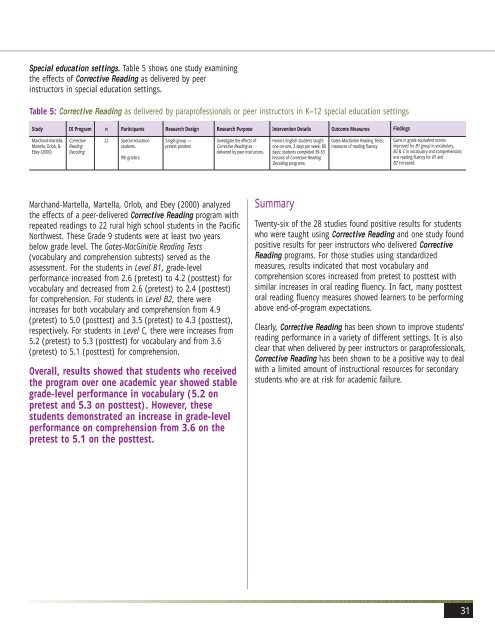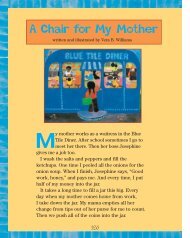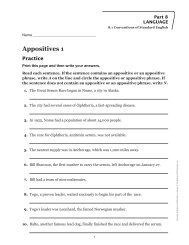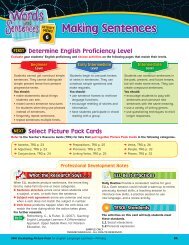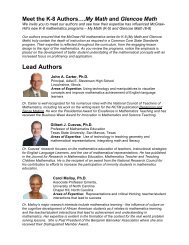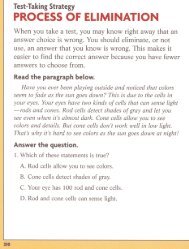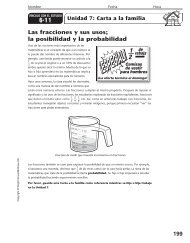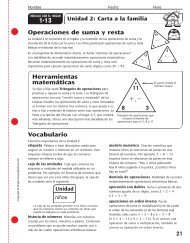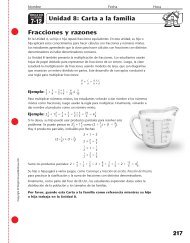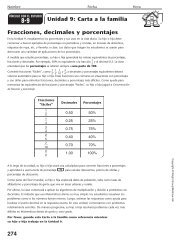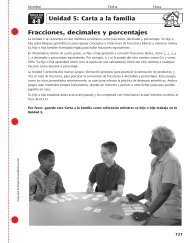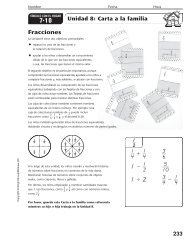Final Pages - MHEonline.com
Final Pages - MHEonline.com
Final Pages - MHEonline.com
You also want an ePaper? Increase the reach of your titles
YUMPU automatically turns print PDFs into web optimized ePapers that Google loves.
Special education settings. Table 5 shows one study examining<br />
the effects of Corrective Reading as delivered by peer<br />
instructors in special education settings.<br />
Table 5: Corrective Reading as delivered by paraprofessionals or peer instructors in K–12 special education settings<br />
Study<br />
Marchand-Martella,<br />
Martella, Orlob, &<br />
Ebey (2000)<br />
DI Program<br />
Corrective<br />
Reading<br />
Decoding<br />
n<br />
22<br />
Participants<br />
Special education<br />
students.<br />
9th graders<br />
Research Design<br />
Single group —<br />
pretest-posttest<br />
Research Purpose<br />
Marchand-Martella, Martella, Orlob, and Ebey (2000) analyzed<br />
the effects of a peer-delivered Corrective Reading program with<br />
repeated readings to 22 rural high school students in the Pacific<br />
Northwest. These Grade 9 students were at least two years<br />
below grade level. The Gates-MacGinitie Reading Tests<br />
(vocabulary and <strong>com</strong>prehension subtests) served as the<br />
assessment. For the students in Level B1, grade-level<br />
performance increased from 2.6 (pretest) to 4.2 (posttest) for<br />
vocabulary and decreased from 2.6 (pretest) to 2.4 (posttest)<br />
for <strong>com</strong>prehension. For students in Level B2, there were<br />
increases for both vocabulary and <strong>com</strong>prehension from 4.9<br />
(pretest) to 5.0 (posttest) and 3.5 (pretest) to 4.3 (posttest),<br />
respectively. For students in Level C, there were increases from<br />
5.2 (pretest) to 5.3 (posttest) for vocabulary and from 3.6<br />
(pretest) to 5.1 (posttest) for <strong>com</strong>prehension.<br />
Overall, results showed that students who received<br />
the program over one academic year showed stable<br />
grade-level performance in vocabulary (5.2 on<br />
pretest and 5.3 on posttest). However, these<br />
students demonstrated an increase in grade-level<br />
performance on <strong>com</strong>prehension from 3.6 on the<br />
pretest to 5.1 on the posttest.<br />
Investigate the effects of<br />
Corrective Reading as<br />
delivered by peer instructors.<br />
Intervention Details<br />
Honors English students taught<br />
one-on-one, 3 days per week, 80<br />
days; students <strong>com</strong>pleted 39-53<br />
lessons of Corrective Reading<br />
Decoding programs<br />
Summary<br />
Out<strong>com</strong>e Measures<br />
Gates-MacGinitie Reading Tests;<br />
measures of reading fluency<br />
Findings<br />
Gains in grade equivalent scores<br />
improved for B1 group in vocabulary,<br />
B2 & C in vocabulary and <strong>com</strong>prehension;<br />
oral reading fluency for B1 and<br />
B2 increased.<br />
Twenty-six of the 28 studies found positive results for students<br />
who were taught using Corrective Reading and one study found<br />
positive results for peer instructors who delivered Corrective<br />
Reading programs. For those studies using standardized<br />
measures, results indicated that most vocabulary and<br />
<strong>com</strong>prehension scores increased from pretest to posttest with<br />
similar increases in oral reading fluency. In fact, many posttest<br />
oral reading fluency measures showed learners to be performing<br />
above end-of-program expectations.<br />
Clearly, Corrective Reading has been shown to improve students’<br />
reading performance in a variety of different settings. It is also<br />
clear that when delivered by peer instructors or paraprofessionals,<br />
Corrective Reading has been shown to be a positive way to deal<br />
with a limited amount of instructional resources for secondary<br />
students who are at risk for academic failure.<br />
31
References<br />
Armbruster, B. B., Lehr, F., & Osborn, J. (2003). Put reading<br />
first: The research building blocks for teaching children to read,<br />
kindergarten through grade 3. Jessup, MD: National Institute<br />
for Literacy.<br />
*Arthur, C. (1988). Progress in a high school LD class. ADI<br />
News, 27(4), 17-18.<br />
*Benner, G. J., Kinder, D., Beaudoin, K. M., Stein, M., &<br />
Hirschmann, K. (in press). The effects of the Corrective<br />
Reading Decoding program on the basic reading skills and<br />
social adjustment of students with high incidence disabilities.<br />
Journal of Direct Instruction.<br />
Biancarosa, G., & Snow, C. E. (2004). Reading next-A vision for<br />
action and research in middle and high school literacy: A report<br />
from Carnegie Corporation of New York. Washington, DC:<br />
Alliance for Excellent Education.<br />
*Campbell, M. L. (1984). Corrective Reading program evaluated<br />
with secondary students in San Diego. ADI News, 3(3), 1.<br />
Carnine, D. W., Silbert, J., Kame’enui, E. J., & Tarver, S. G.<br />
(2004). Direct instruction reading (4th ed.). Upper Saddle<br />
River, NJ: Pearson/Merrill/Prentice Hall.<br />
*Clunies-Ross, G. (1990). Some effects of direct instruction in<br />
<strong>com</strong>prehension skills on intellectual performance. ADI News,<br />
9(3), 18-21.<br />
*Drakeford, W. (2002). The impact of an intensive program to<br />
increase the literacy skills of incarcerated youth. Journal of<br />
Correctional Education, 53(4), 139-144.<br />
*Edlund, C. V., & Ogle, R. R. (1988). Amount of training in DI<br />
and out<strong>com</strong>es with secondary handicapped students. ADI<br />
News, 7(3), 14-15.<br />
Engelmann, S., Hanner, S., & Johnson, G. (1999). Corrective<br />
Reading series guide. Columbus, OH: SRA/McGraw-Hill.<br />
*Flores, M. M., Shippen, M. E., Alberto, P., & Crowe, L. (2004).<br />
Teaching letter-sound correspondence to students with<br />
moderate intellectual disabilities. Journal of Direct<br />
Instruction, 4, 173-188.<br />
* Indicates the studies included in the research review.<br />
32<br />
Francis, D. J., Shaywitz, S. E., Stuebing, K. K., Shaywitz, B. A.,<br />
& Fletcher, J. M. (1996). Developmental lag versus deficit<br />
models of reading disability: A longitudinal, individual growth<br />
curves analysis. Journal of Educational Psychology, 88, 3-17.<br />
*Gersten, R., Brockway, M. A., & Henares, N. (1983). The<br />
Monteray DI program for students. ADI News, 2(4), 8-9.<br />
*Glang, A., Singer, G., Cooley, E., & Tish, N. (1991). Using<br />
Direct Instruction with brain injured students. ADI News,<br />
11(1), 23-27.<br />
*Gregory, R. P., Hackney, C., & Gregory, N. M. (1982).<br />
Corrective Reading programme: An evaluation. British Journal<br />
of Educational Psychology, 52, 33-50.<br />
*Harris, R. E., Marchand-Martella, N. E., Martella, R. C. (2000).<br />
Effects of a peer-delivered Corrective Reading program. Journal<br />
of Behavioral Education, 10, 21-36.<br />
*Herr, C. M. (1989). Using Corrective Reading with adults.<br />
ADI News, 8(2), 18-21.<br />
*Holdsworth, P. (1984–85). Corrective Reading tested in U.K.<br />
ADI News, 4(2), 1, 4-5.<br />
*Kasendorf, S. J., & McQuaid, P. (1987). Corrective Reading<br />
evaluation study. ADI News, 7(1), 9.<br />
*Keel, M. C., Fredrick, L. D., Hughes, T. A., & Owens, S. H.<br />
(1999). Using paraprofessionals to deliver Direct Instruction<br />
reading programs. Effective School Practices, 18(2), 16-22.<br />
*Lewis, A. (1982). An experimental evaluation of a Direct<br />
Instruction programme (Corrective Reading) with remedial<br />
readers in a <strong>com</strong>prehensive school. Educational Psychology,<br />
2(2), 121-135.<br />
*Lloyd, J., Cullinan, D., Heins, E. D., & Epstein, M. H. (1980).<br />
Direct Instruction: Effects on oral and written language<br />
<strong>com</strong>prehension. Learning Disability Quarterly, 3(4), 70-76.<br />
Lyon, G. R. (2001). Measuring success: Using assessments and<br />
accountability to raise student achievement. Sub<strong>com</strong>mittee on<br />
Education Reform Committee on Education and the Workforce,<br />
U.S. House of Representatives. Washington, D.C. Retrieved<br />
March 24, 2003, from http://www.nrrf.org/lyon_statement3-<br />
01.htm.
*Malmgren, K. W., & Leone, P. E. (2000). Effects of a short-term<br />
auxiliary reading program on the reading skills of incarcerated<br />
youth. Education & Treatment of Children, 23, 239-247.<br />
Marchand-Martella, N. E., & Martella, R. C. (2002). An overview<br />
and research summary of peer-delivered Corrective Reading<br />
instruction. Behavior Analysis Today, 3, 213-220.<br />
Marchand-Martella, N. E., Martella, R. C., Bettis, D. F., & Riley<br />
Blakely, M. (2004). Project Pals: A description of a high<br />
school-based tutorial program using Corrective Reading and<br />
peer-delivered instruction. Reading and Writing Quarterly,<br />
20, 179-201.<br />
*Marchand-Martella, N. E., Martella, R. C., Orlob, M., & Ebey, T.<br />
(2000). Conducting action research in a rural high school<br />
setting using peers as Corrective Reading instructors for<br />
students with disabilities. Rural Special Education Quarterly,<br />
19 (2), 20-29.<br />
Meese, R. L. (2001). Teaching learners with mild disabilities:<br />
Integrating research and practice (2nd ed.). Belmont, CA:<br />
Wadsworth/Thomson Learning.<br />
National Institute for Child Health and Human Development<br />
(2000). Report of the National Reading Panel: Teaching<br />
children to read: An evidence-based assessment of the scientific<br />
research literature on reading and its implications for reading<br />
instruction. Reports of the subgroups. (NIH Publication No.<br />
00-4754). Washington, DC: U.S. Government Printing Office.<br />
*Polloway, E. A., Epstein, M. H., Polloway, C. H., Patton, J. R.,<br />
& Ball, D. W. (1986). Corrective Reading program: An analysis<br />
of effectiveness with learning disabled and mentally retarded<br />
students. Remedial and Special Education, 7(4), 41-47.<br />
Reyna, V. F. (2004). Why scientific evidence? The importance of<br />
evidence in changing educational practice. In P. McCardle & V.<br />
Chhabra (Eds.), The voice of evidence in reading research<br />
(pp. 47-80). Baltimore, MD: Paul H. Brookes.<br />
*Scarlato, M. C., & Asahara, E. (2004). Effects of Corrective<br />
Reading in a residential treatment facility for adjudicated<br />
youth. Journal of Direct Instruction, 4, 211-217.<br />
*Short, C., Marchand-Martella, N. E., Martella, R. C., & Ebey, T. L.<br />
(1999). The benefits of being high school Corrective Reading<br />
peer instructors. Effective School Practices, 18(2), 23-29.<br />
*Sommers, J. (1995). Seven-year overview of Direct Instruction<br />
programs used in basic skills classes at Big Piney Middle<br />
School. Effective School Practices, 14(4), 29-32.<br />
*Somerville, D. E., & Leach, D. J. (1988, February). Direct or<br />
indirect instruction?: An evaluation of three types of<br />
intervention programs for assisting students with specific<br />
reading difficulties. Educational Research, 30(1), 46-53.<br />
*Steventon, C. E., & Frederick, L. D. (2003). The effects of<br />
repeated readings on student performance in the Corrective<br />
Reading program. Journal of Direct Instruction, 3(1), 17-27.<br />
*Thomson, B. (1992). A field report: Specific learning<br />
disabilities Corrective Reading pilot study 1989-90. ADI News,<br />
11(2), 11-13.<br />
*Thorne, M. T. (1978). Payment for reading: The use of the<br />
‘Corrective Reading scheme’ with junior maladjusted boys.<br />
Remedial Education, 13(2), 87-90.<br />
U.S. Department of Education. Office of the Under Secretary<br />
(2002). No Child Left Behind: A Desktop Reference.<br />
Washington, DC: Author.<br />
*Vitale, M., Medland, M., Romance, N., & Weaver, H. P. (1993).<br />
Accelerating reading and thinking skills of low-achieving<br />
elementary students: Implications for curricular change.<br />
Effective School Practices, 12(1), 26-31.<br />
* Indicates the studies included in the research review.<br />
33
R80001419<br />
0905<br />
Give struggling readers research-based,<br />
proven tools for success<br />
In a climate where accountability has never<br />
counted more, numerous studies document<br />
the effectiveness of Corrective Reading.<br />
The program’s two strands, Decoding and<br />
Comprehension, and four instructional levels<br />
address a wide range of reading problems.<br />
Discover the research base and validation<br />
that suggest the Corrective Reading<br />
program can close the achievement gap<br />
for a wide range of students who are<br />
performing below grade level expectations.


